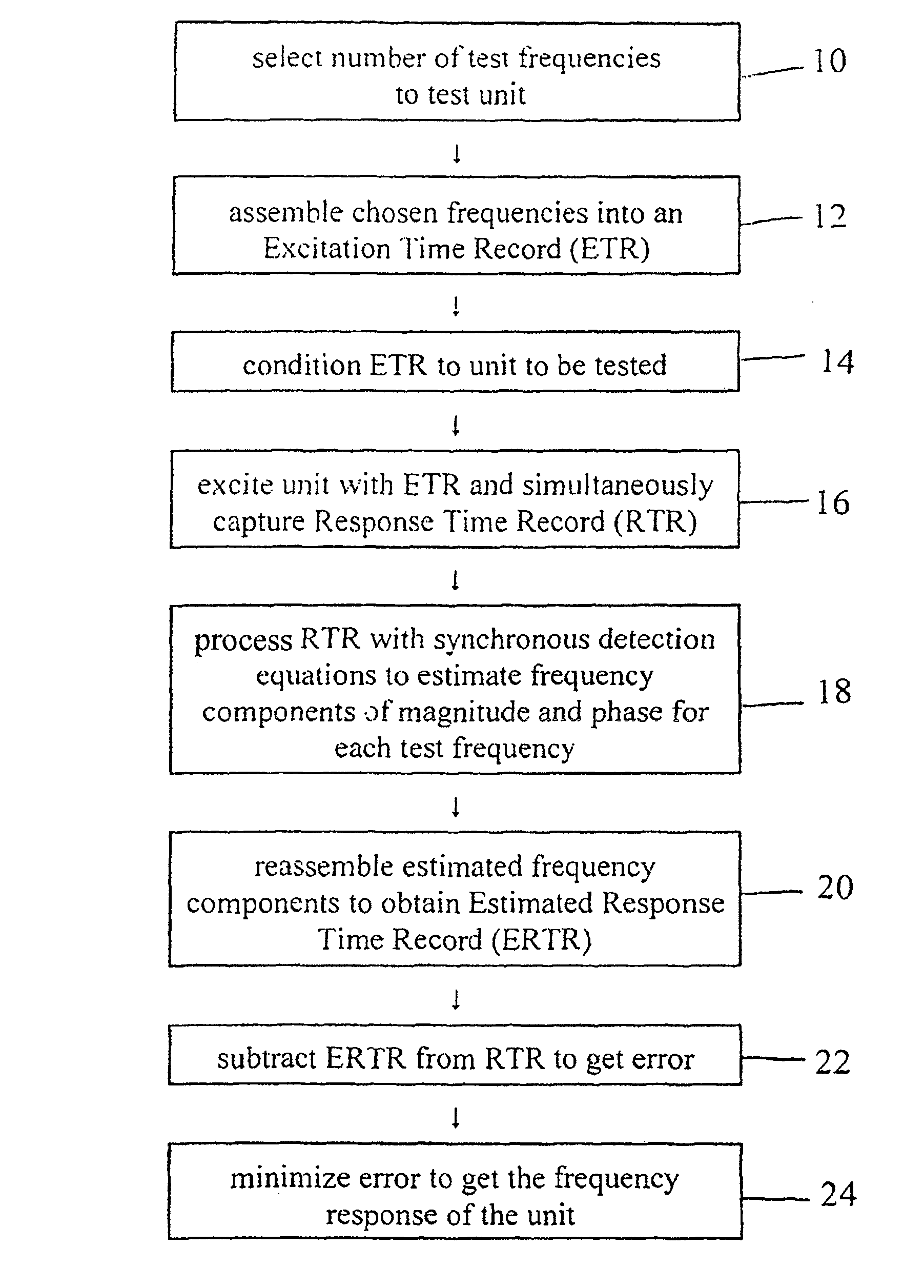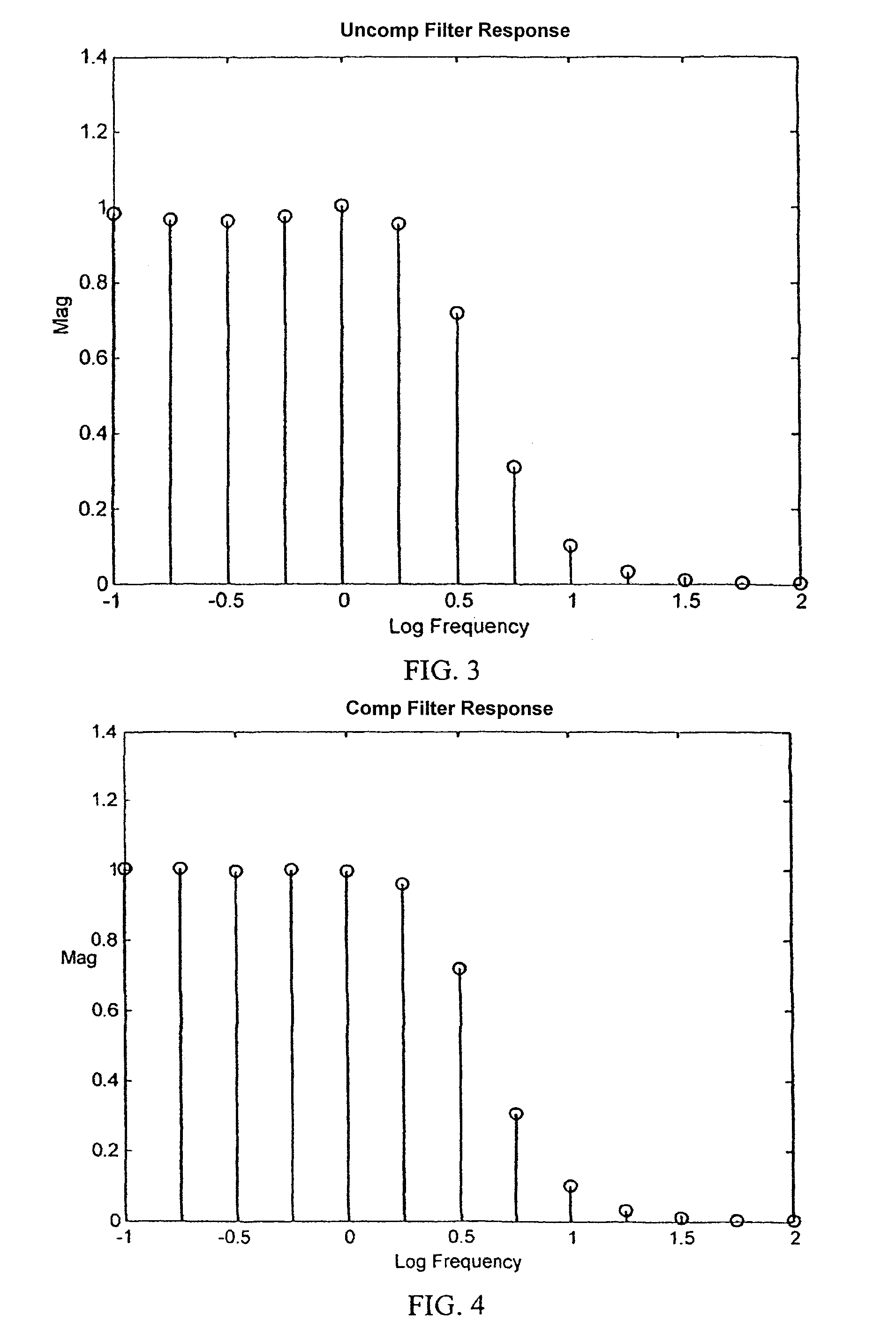Method of detecting system function by measuring frequency response
a technology of frequency response and detection system, applied in the direction of pulse characteristics measurement, testing circuit, instruments, etc., can solve the problems of time-consuming and effective methods, and achieve the effect of reducing testing tim
- Summary
- Abstract
- Description
- Claims
- Application Information
AI Technical Summary
Benefits of technology
Problems solved by technology
Method used
Image
Examples
example 1
Analytical Testing on a Sum of Sines
[0095]The CSD algorithm was evaluated using a simple signal that was assembled from a finite sum of equal amplitude sine waves (Sum of Sines (SOS)) with frequencies distributed logarithmically over a limited range. The objective of the analysis was to assess how well the CSD algorithm could pick out an amplitude for each component.
[0096]To check out the concept analytically, a MATLAB® matrix calculation computer software code was written that was a logarithmic mix of 5 equal unity amplitude frequencies (50.5, 51, 51.5, 52, 52.5 Hz). The acquired time record was set to 10 periods of the lowest frequency and the time step was set to 1 / 10 of the period of the highest frequency. As per Equation 9, error-free detection should estimate the amplitude of 0.5 for each component. Table 1 gives an estimate for a first pass or simple synchronous detection and a second pass, the CSD algorithm. The MATLAB® matrix calculation computer software code for this anal...
example 2
Analytical Testing of a Low-Pass Filter
[0099]A recursive model of a second order low-pass function was excited with an SOS input signal. The CSD algorithm was then used to estimate the frequency response at each of the specific frequencies making up the SOS.
[0100]A spread of 13 specific frequencies was chosen that were spaced in ¼ decade steps starting from 0.1 Hz up to 100 Hz. Using these frequencies, a mix of equal unity amplitude sine waves was created. This range of frequencies was picked as research performed at the Idaho National Laboratory with batteries is typically over this frequency spread. The signal was discretized with a time step that was 10% of the period of the highest frequency. The length of the time record was set at 10 periods of the lowest frequency.
[0101]A recursive model of a second order Butterworth low-pass function was developed. A center frequency was set at the middle of the SOS frequency spread. A filter response to the SOS input time profile was comput...
example 3
Analytical Testing of CSD with a Battery Model
[0103]The CSD algorithm was evaluated analytically via a computer simulation of the detection of the impedance of the Lumped Parameter Model of a battery (LPM) that was developed by the Idaho National Laboratory (INL) (see, FreedomCAR Battery Test Manual, 2003). A computer model for the LPM that will simulate battery voltage response to an arbitrary battery current was also developed at INL by Fenton et al., 2005. The voltage response of the model normalized to the current in the frequency domain will be the battery impedance. The equivalent circuit for the LPM with parameter identification is shown in FIG. 6.
[0104]The LPM was excited with a current source IIN that was an SOS, and the CSD algorithm was used to identify the impedance seen looking into the LPM over a limited range of discrete frequencies. It should be noted that the polarity of the voltage response was defined as negative because the SOS excitation current was a discharge ...
PUM
 Login to View More
Login to View More Abstract
Description
Claims
Application Information
 Login to View More
Login to View More - R&D
- Intellectual Property
- Life Sciences
- Materials
- Tech Scout
- Unparalleled Data Quality
- Higher Quality Content
- 60% Fewer Hallucinations
Browse by: Latest US Patents, China's latest patents, Technical Efficacy Thesaurus, Application Domain, Technology Topic, Popular Technical Reports.
© 2025 PatSnap. All rights reserved.Legal|Privacy policy|Modern Slavery Act Transparency Statement|Sitemap|About US| Contact US: help@patsnap.com



